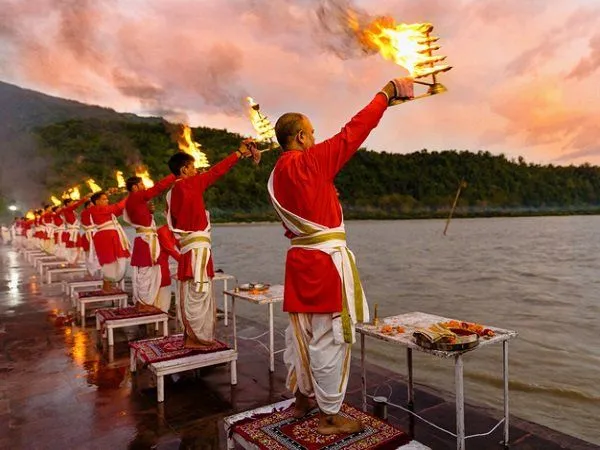Ganga Saptami

“नदियः पृथ्व्याः जीवनधारा यस्याः संरक्षणं सर्वेषां दैविकम्। प्राणिनां निवासस्थानं यस्याः प्रदेशः पावनः, तस्याः संरक्षणं सर्वेषां मोक्षमयम्।”
Translation:
“Rivers are the life veins of the Earth, whose protection is divine for all. Their regions are abodes of life, sanctified, and their preservation leads to liberation for all.”
In the heart of India, where the mighty Ganges River flows, lies a day of profound significance known as Ganga Saptami. This day, celebrated with great reverence and devotion, marks the birth of the goddess Ganges, a symbol of purity, life, and spiritual enlightenment. The Ganges, revered as a divine entity, is considered the lifeblood of India, flowing through the country’s heartland and touching the lives of millions.
Among all the rivers of India, the Ganges is considered the holiest. Fondly called Ganga Maiya by devotees, Gangajal, the water of Ganga, is pure and used for spiritual purification and religious ceremonies. A bottle of gangajal can be found in every Hindu household.
The seventh day of the Shukla paksh of the Baisakh month of the Hindu calendar is known as Ganga Saptami. This day is believed to be the birthday of Ganga and is widely celebrated.
According to mythology, Ganga once resided in heaven. It was due to the great penance and efforts of King Bhagirath that she came to Earth. Bhagirath, the king of Ayodhya and an ancestor of Lord Ram, brought Ganga to Earth so that his ancestors, the 60,000 sons of Raja Sagara, who were reduced to ashes by Kapil Muni, could attain moksha.
Ganga Saptami is also called ‘Jahnu Saptami’, honoring the great Rishi Jahnu. Recently, I came across an interesting story of this incident and the formation of Navadvip in West Bengal. Navadvip is best known as the birthplace of Shri Chaitanya Mahaprabhu and is located on the banks of the river Ganga.
The story goes that when Ganga descended on Earth, she followed the path taken by Bhagirath, who was riding on a chariot. The path passed through present-day Navadvip, where a great Rishi Jahnu lived in an ashram. The force of water entered his ashram and caused much destruction. This angered the Rishi, and to punish Ganga, he drank the water in a gulp.
After some time, Bhagirath noticed that Ganga was not following him and returned to find out the matter. Upon learning what had happened, Bhagirath begged for forgiveness and asked for the river to be returned so that the purpose of her descent could be fulfilled. Rishi Jahnu agreed and released her through his ears. Thus, Ganga came to be known as Jahnavi, the daughter of Jahnu. The day is called ‘Jahnu Saptami’ and is celebrated as the rebirth of Ganga.
Bhagirath and Ganga set off again. Ganga was now divided into several streams, forming nine islands known as Navadvip. This site is located on the Navadvip-Katwa road and is marked by a huge Banyan tree. Ganga originates from the Himalayas in the north and travels eastward, covering a distance of almost 2500 km, before falling into the Bay of Bengal. The place where Ganga meets the sea is called Gangasagar, believed to be the location of Kapil Muni’s ashram. Ganga washed away the ashes of Bhagirath’s ancestors, allowing them to attain Moksha.
Ganga Saptami is an important day for those living around the river. Devotees visit the river to take a holy dip and perform special puja.
The significance of Ganga Saptami extends beyond religious rituals; it is also a day of environmental awareness and conservation. Despite its immense importance, the river faces numerous challenges, including pollution and overuse. On Ganga Saptami, individuals and communities come together to pledge their commitment to preserving the river, emphasizing the need for sustainable practices and responsible stewardship.
Cultural festivals like Ganga Saptami serve as powerful reminders of the importance of respecting and protecting nature. In modern times, Ganga Saptami has evolved into a platform for raising awareness about the critical need to clean and preserve the river. Numerous NGOs and community groups organize events such as Karm Daan, where volunteers come together to spend a few hours cleaning nearby rivers. These initiatives not only contribute to the physical cleanliness of the water bodies but also foster a sense of community and shared responsibility towards environmental conservation. Through such activities, Ganga Saptami underscores the message that every individual has a role to play in safeguarding our natural heritage, encouraging a shift towards more sustainable and environmentally conscious lifestyles.
Citations: